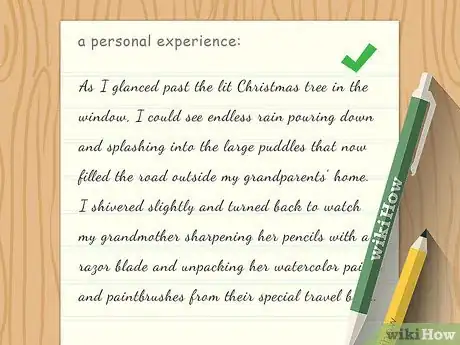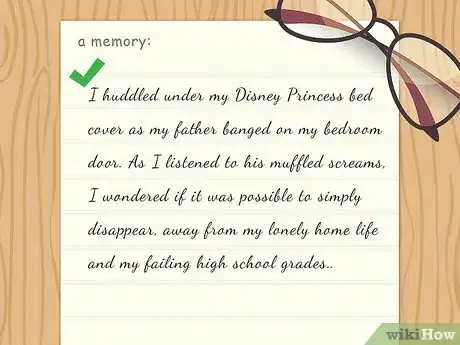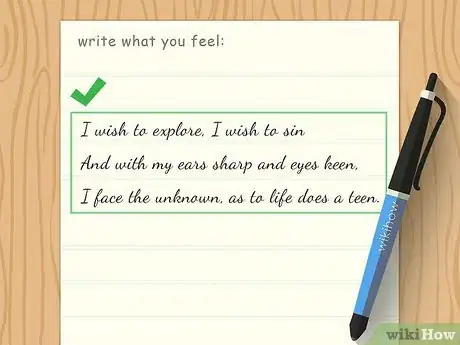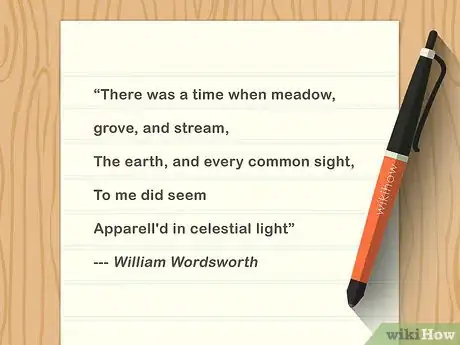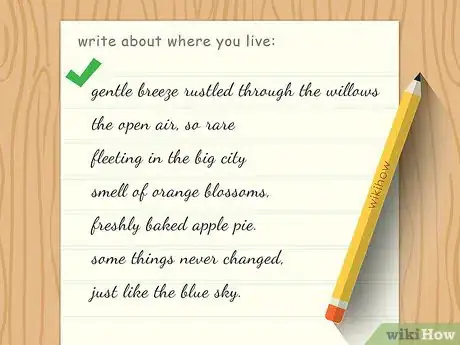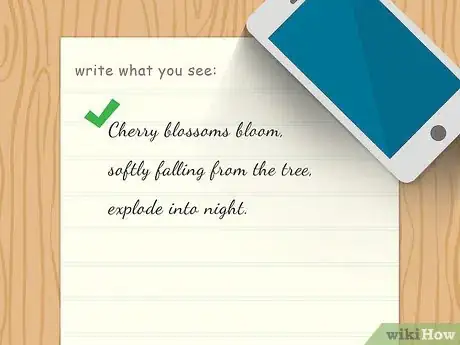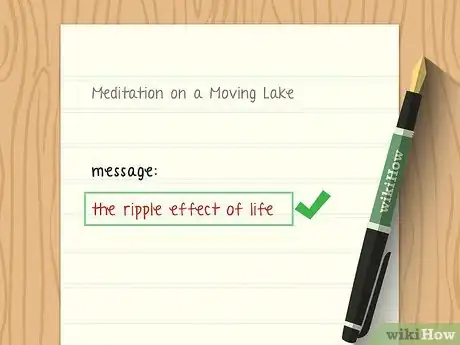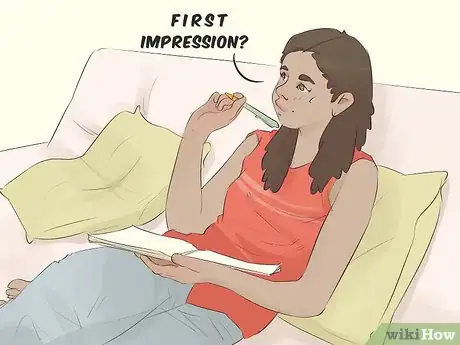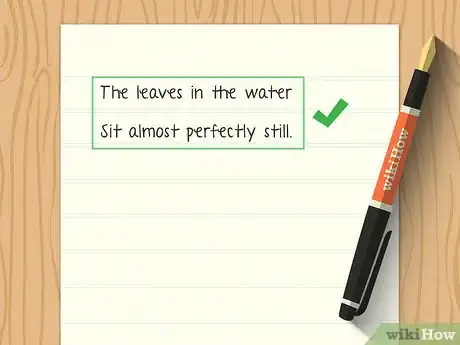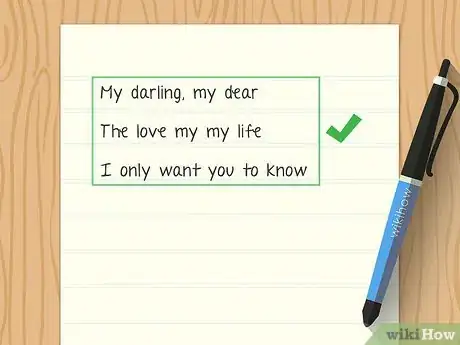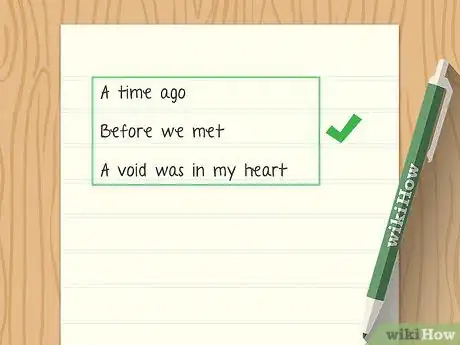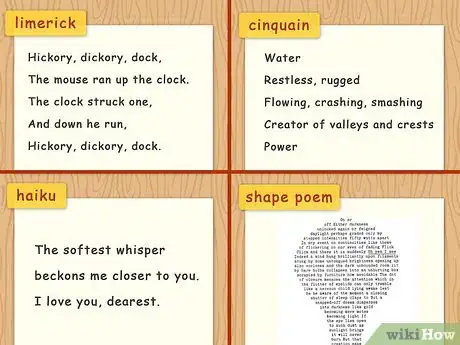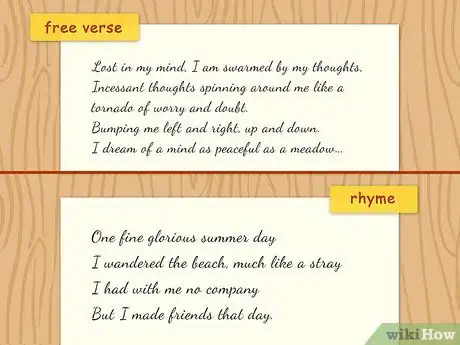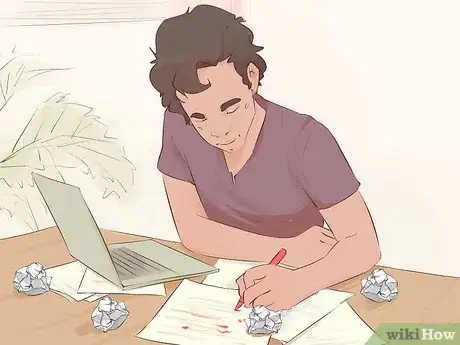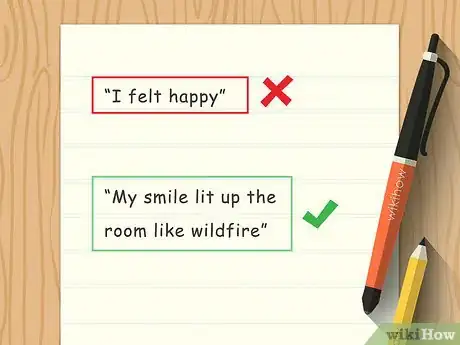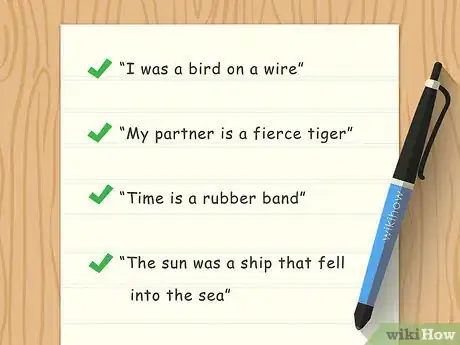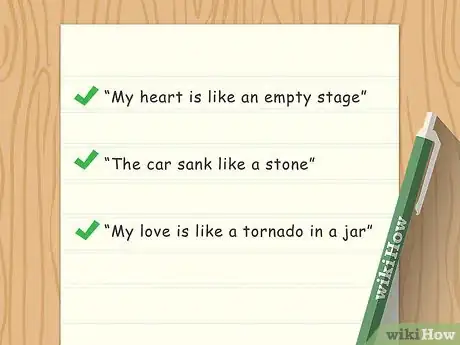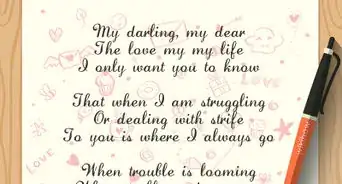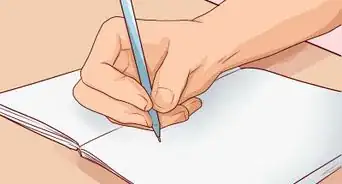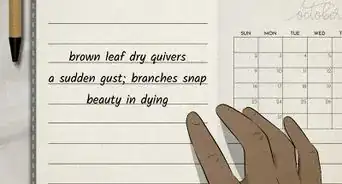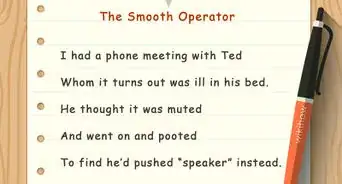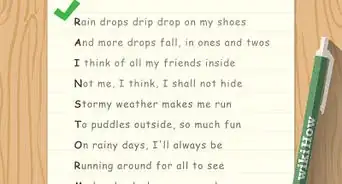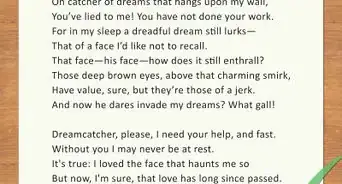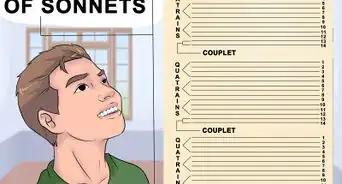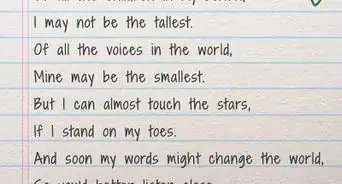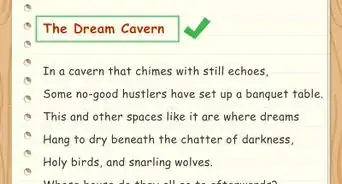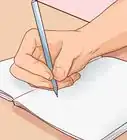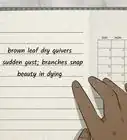This article was co-authored by Jamie Korsmo, PhD. Jamie Korsmo is a Ph.D. candidate in English at Georgia State University.
There are 12 references cited in this article, which can be found at the bottom of the page.
This article has been viewed 143,222 times.
Poetry is one of the most beautiful forms of writing. Because of its attention to form and diction, poetry is often able to powerfully impact the reader and leave a lasting impression. Poetry allows the author to express his or her emotions through language on a level that prose often can't attain. This article will advise on the steps to beginning a poem of your own.
Steps
Drawing from Your Personal Experiences and Environment
-
1Write about what you know. Writing about things you have personally experienced makes you a credible author and this will allow your readers to relate to you more effectively through your poem.[1]
- While it is possible to write about things that you have simply imagined rather than experienced, it is harder to recreate the scenario or translate the emotions into written word if it is not based on your lived experience, especially if you are new to writing poetry. It is possible that the message you end up conveying will be too shallow or transparent and this will make your reader less likely to trust your authority as an author.
-
2Use your memories. Incorporating your actual memories into your writing will allow you to paint a much clearer picture for the reader because it is based on a reality that you can reflect on, rather than creating all new details.[2]
- Think about significant moments in your life and try to remember specific details. Think about how things looked, smelled, and even how you felt at the moment.
Advertisement -
3Use poetry as a personal reflection. Writing about your feelings and your experiences can be very therapeutic.[3] [4] Writing about your past, especially about traumatic experiences, is an effective way to help you heal.
- Try to share honestly about what you felt in your poetry. This will make your reader relate more strongly to your poems and it may also help you move forward through the emotions.
-
4Build upon historical precedent. Historically, many poems have been written about nature or the environment in which the author lives.
- In his "Ode on Intimations of Immortality from Recollections of Early Childhood," William Wordsworth begins with, There was a time when meadow, grove, and stream, / The earth, and every common sight, / To me did seem / Apparell'd in celestial light.[5]
- In Wordsworth's poem, the natural world is the main topic. Wordsworth reflects on how nature made him feel as a child and it is a powerful experience to which the reader can relate.
-
5Write about where you live. Take a walk outside or go observe people at your favorite coffee shop. Notice the details of the places you are familiar with and write them down.
- Think about what characteristics make a particular place unique. How is this place different from others - is it the people, the architecture, or the regional food?
- Writing about a place you already know will help you get to the heart of the place in your writing.
-
6Write what you see. Start carrying a notebook around with you everywhere and jot down details about things that you see in your everyday life. Pay particular attention to things that are beautiful or that make you feel something.[6]
- Try describing a particularly beautiful sunset or an interaction you observe between two children at the park.
Conceptualizing an Idea
-
1Figure out what you want to say. Every poem has a purpose. Maybe that purpose is to express a certain emotion or to sing the praises of a place or person. Focusing on your emotions can help you choose a topic because writing about something you are passionate about is always a good place to start.[7]
-
2Narrow your topic. Some issues or situations are too broad to encompass the entire thing in one poem. Think about your topic and decide if it's narrow enough to write about.[8]
- For example, maybe you want to write about your experience being a parent. But it would be a very difficult feat to write about the entire experience of parenthood. Perhaps you could focus your energies on writing about one aspect of this situation such as becoming a parent for the first time, or your frustration with your child's sleeping pattern, or the pride you feel when your child learns something new. Narrowing your focus will help you get your point across more effectively.
-
3Identify your message. Once you have decided on your topic and narrowed it down, you can think about what you want your poem to express. Your message is the thing that a person who reads your poem will walk away remembering. Maybe you want to express the universality of a certain emotion or to tell your reader that they are not alone in their experiences. Whatever your message, make sure it's clear in your mind before you start writing so that it will be clear in your poem.[9]
Getting the First Words Down
-
1Think about the first impression you want to leave with your readers. The opening lines of a poem can be some of the most memorable and powerful of the entire poem. It is your readers' first interaction with you and your emotions.
- Consider what you want to share with your readers and focus on that as you begin writing.
-
2Begin with an image. An image can be a great way to start because it can set the scene for the rest of the poem.[10]
- If you want to write a love poem about your relationship, perhaps you could begin with the image of a delicate flower that grows with the nurturing of its environment (light from the sun, nutrients from the soil, etc.). In this way, you are setting up a comparison between your relationship and this beautiful flower that the reader can relate to and that will help your reader understand your point.
-
3Begin with an emotion. Emotions can be the most powerful things a person will experience in their life. And everyone feels emotions, so expressing them is a great way to make a connection with your reader. Rage or joy, sorrow or elation: these are all emotions that other people have also experienced. So examining these emotions and describing how they impacted you will help draw your reader in to the poem.[11]
-
4Begin with an occurrence. Events have the power to shape the course of our lives or change the way we think about the world. Big events certainly change us, but so do smaller encounters.
- An exchange with a stranger can alter how you view a subject; watching two people who are clearly in love can make you want to reignite the fire in your own relationship.
- Examining the importance of these events that make us think differently, even the small ones, can also impact your reader in the same way it affected you.
Focusing on Form
-
1Think about the kind of poem you want to write. Form can help establish meaning by drawing the reader's attention to particular parts or by simply making the poem more appealing/memorable through repetition, rhyme, and other poetic devices. A few common poetic forms with a long history are:[12]
- Haiku- a 3-line poem containing lines of 5, then 7, then 5 syllables
- Sonnet- a 14-line poem made of an octave (8 lines) and a sestet (6 lines) or three quatrains (4 lines) and a couplet (2 lines)
- Sestina- a poetic form involving 6 6-line stanzas followed by a 3-line stanza with a complex repetition of the final word of each line of poetry
- Prose poem- a type of poem without traditional poetry line breaks which looks like prose but maintains other elements of poetry
-
2Read poetry. What we read influences how we write. If you want to write poetry in a classical Greek style, read classical Greek poetry. If you want to mimic Walt Whitman's flowing free-verse, read some of Walt Whitman's memorable poetry.
- Reading other great writers is one of the best ways to improve your own writing skills.
-
3Decide if you want to write in rhyme or free verse. Rhyming poetry can be more memorable and can flow more enjoyably for the reader. However, this form can be more limiting in content (when you have to choose a word that rhymes with another word instead of being able to choose the word you actually mean.)[13]
- Here is an example of a rhyming poem. This is the beginning of Shakespeare's "Sonnet 28." Notice the standard ABAB rhyming scheme: Shall I compare thee to a summer's day? / Thou art more lovely and more temperate: / Rough winds do shake the darling buds of May, / And summer's lease hath all too short a date[14]
- Free verse poems are not constricted by end rhymes and can flow however the author sees fit. As example, here is a portion of Walt Whitman's famous free-verse poem "Song of Myself": There was never any more inception than there is now, / Nor any more youth or age than there is now, / And will never be any more perfection than there is now, / Nor any more heaven or hell than there is now.[15] This section of the poem uses repetition of than there is now, but it does not adhere to any rhyme scheme.
-
4Practice freewriting. Freewriting is a kind of brainstorming used in writing where you force yourself to continuously write for a given period of time. This is a good way to start getting some of your ideas on paper that you can draw from when writing your poem.[16]
- During the freewriting process, don't worry about grammar or punctuation. The most important thing is to just keep writing and never pull your pencil away from the page. You can freewrite for three minutes or twenty. It's up to you. Freewriting helps you get all of your ideas on the page and to make connections between these ideas that may have been previously buried under the surface.
-
5Make several drafts. Start writing your poem and just keep going until you feel satisfied with it. You can start with just one verse or try to finish the whole thing. Take a break from writing and then go back to the poem and revise. Change the word order or rewrite entire lines. Make as many changes/drafts as you need to.
Utilizing Diction
-
1Pay attention to your word choice. More than in any other form of writing, diction and word choice matter in poetry. Try using descriptive words that paint a more elaborate picture.[17]
- For example, you could say that it was a dark, shadowy night instead of just that the night was dark. This is much more descriptive and gives the reader a more accurate picture of what you mean.
-
2Implement metaphors.[18] Metaphors directly compare two things based on similarities by equating them as the same.
- In his play As You Like It, William Shakespeare famously says, All the world's a stage, / And all the men and women merely players: / They have their exits and their entrances. This is a metaphor that compares the action of real life with the action of a theatrical play. Shakespeare says that world is a stage and all the people are actors, not merely that they are like actors.
-
3Use analogies. Analogies are comparisons between two things that intend to help the reader understand a situation or event. Usually, authors compare a known thing with a lesser known thing to help the reader understand the lesser known thing. Unlike metaphors that compare a thing by saying it is another thing, analogies say that something is like something else.
- For example, saying she was as quiet as a mouse is an analogy that lets the reader know something about the subject, she, by relating a fact about her to a fact everyone knows (that mice are quiet).
Community Q&A
-
QuestionMust poetry be short?
 Community AnswerNot at all. Look up "epic poetry." Homer's "Odyssey" is 12,000 lines long.
Community AnswerNot at all. Look up "epic poetry." Homer's "Odyssey" is 12,000 lines long. -
QuestionI'm writing a poem on the situation we all are going through. Where should I start the poem?
 Audrey BarriaCommunity AnswerYou can start with emotion, scenery, an event, dialogue, or something else. Whatever you do, use vivid description!
Audrey BarriaCommunity AnswerYou can start with emotion, scenery, an event, dialogue, or something else. Whatever you do, use vivid description!
References
- ↑ http://www.nytimes.com/2014/03/30/books/review/write-what-you-know-helpful-advice-or-idle-cliche.html?_r=0
- ↑ https://powerpoetry.org/resources/writing-memory-poems
- ↑ https://www.sciencedaily.com/releases/2007/06/070622090727.htm
- ↑ http://www.socialworker.com/feature-articles/practice/Poetry_Therapy%3A_Using_Words_to_Heal/
- ↑ http://www.bartleby.com/101/536.html
- ↑ https://grammar.yourdictionary.com/grammar-rules-and-tips/tips-on-writing-poems.html
- ↑ https://www.grammarly.com/blog/how-to-write-a-poem/
- ↑ https://www.grammarly.com/blog/how-to-write-a-poem/
- ↑ https://www.grammarly.com/blog/how-to-write-a-poem/
- ↑ https://www.grammarly.com/blog/how-to-write-a-poem/
- ↑ https://grammar.yourdictionary.com/grammar-rules-and-tips/tips-on-writing-poems.html
- ↑ https://www.poetryfoundation.org/learn/glossary-terms?category=forms-and-types
- ↑ https://grammar.yourdictionary.com/grammar-rules-and-tips/tips-on-writing-poems.html
- ↑ http://www.shakespeares-sonnets.com/sonnet/18
- ↑ http://www.english.illinois.edu/maps/poets/s_z/whitman/song.htm
- ↑ https://examples.yourdictionary.com/examples-of-free-verse-poems.html
- ↑ https://grammar.yourdictionary.com/grammar-rules-and-tips/tips-on-writing-poems.html
- ↑ http://literarydevices.net/metaphor/
About This Article
To start a poem, try using an image to set the scene for the rest of the poem. For example, if you want to write a love poem, you could start with the image of a flower that grows with the nurturing of the sun and soil to compare to your relationship that grows with acts of love. Alternatively, you could begin with an event, like you’re watching two people madly in love, and this leads you to want to reignite the fire in your own relationship. For more tips from our reviewer, including how to write different kinds of poems like haikus and sonnets, read on!
